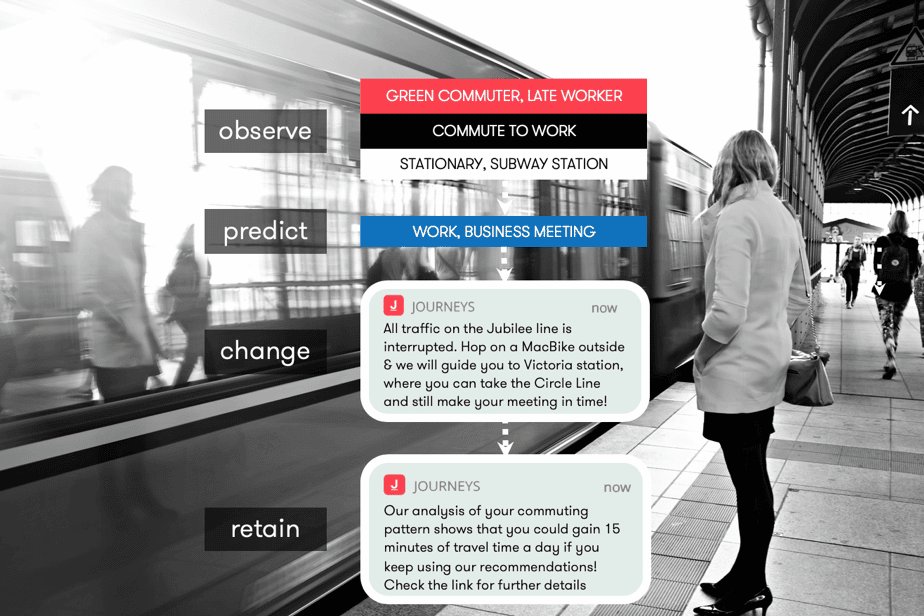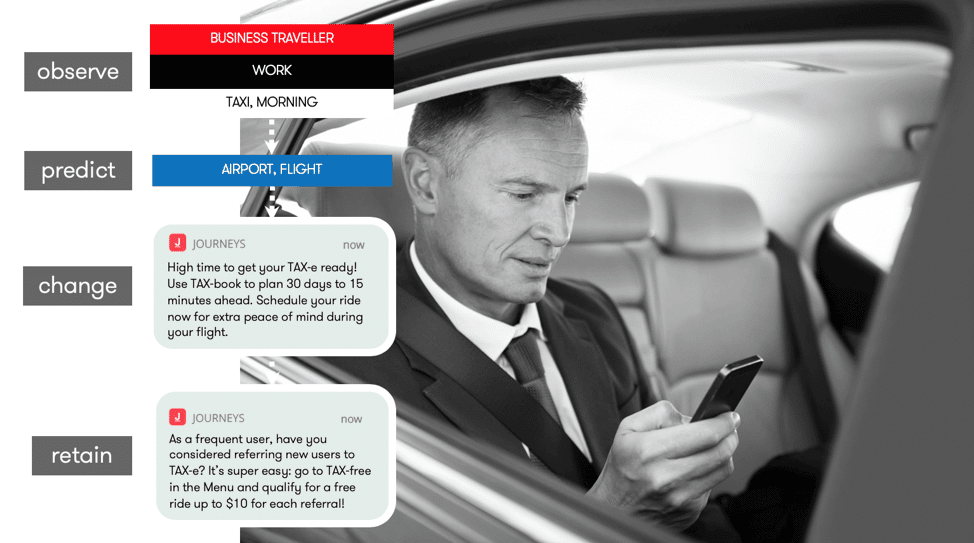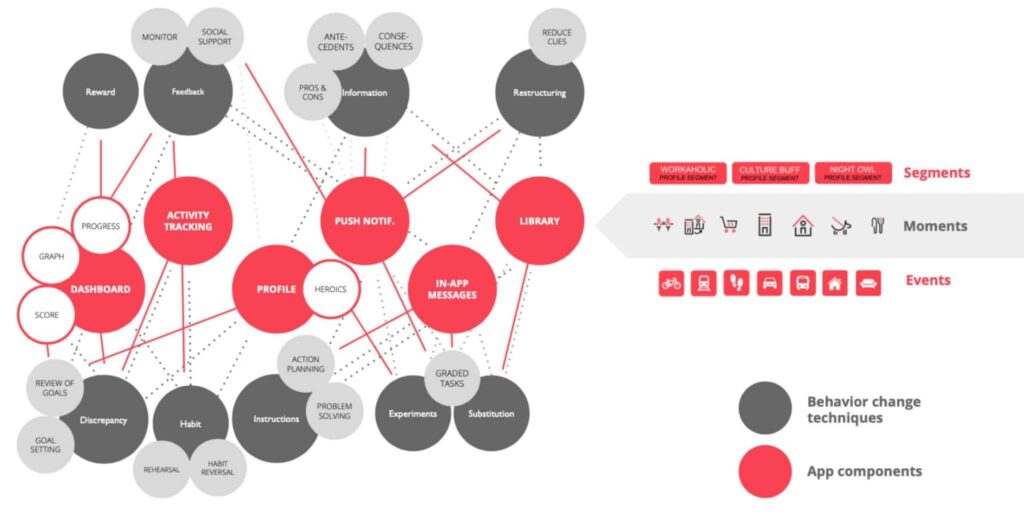At Sentiance, we apply behavioral science to realize the full potential of our contextual insights, detections, and predictions. We observe, predict, and change behavior, while retaining users on our clients’ applications.
This requires negotiating our way into a user’s needs amidst the chaos of everyday life and delivering the right content at the right moment.
Sentiance’s machine learning and behavioral science allows for customization to a user’s persona, their current behavior and specific moments in their life. For example, people about to drive their car should not get messages to meditate. They should be advised of traffic delays and weather conditions for an efficient and safe journey - preferably just before they put the key in the ignition.
The Sentiance platform allows detection of a user’s location, activity, and context based on machine learning. These detections are combined into contextual insights and predictions of lifestyle and behavioral routines. Our customers regularly depend on Sentiance’s know-how in delivering the right message at the right time.
Sentiance acquired BrandNewHealth at the end of 2018 to strengthen our digital offerings to health and mobility providers through behavioral change.
But changing a user’s behavior is easier said than done: good habits are often dull, risky behavior is more fun, short-term benefits are alluring, and everyday life can be exhausting. Digital behavior change is even more challenging, lacking the personal interaction that often drives motivation.
That is where applied behavioral science comes into play. This approach aims to understand why human beings behave the way they do in order to create the right circumstances to support behavioral change. It combines aspects of many disciplines, including psychology, cognitive science, and neuroscience; and integrates behavioral aspects of among others, economics, biology, psychiatry, and law.
Empirical evidence supports the multitude of behavior change theories initially stemming from psychology and more recently, also from economics (e.g. nudging) and engineering (e.g. persuasive systems design). Although the authors of the earliest models were often dogmatic, more recently there is consensus that concepts from various models are of value: intentions, beliefs, attitudes; motivation and self-control; autonomy, competence, relatedness …
How do we put applied behavioral science into practice?
For every part of the user journey (onboarding, dashboard, measurement & feedback, advice,...) we carefully consider which behavior change techniques can be implemented. We define behavior change techniques as techniques that result in behavior change, irrespective of the target behavior, discipline, or area of interest (e.g. mobility, finance, health, environment).
The more techniques implemented, the stronger the induced behavior change. This is why Sentiance relies on BrandNewHealth’s ten years of expertise in digital health coaching - and their internationally acclaimed use of BCT’s.

Real-world applications are demanding
Because empirical support for behavior change theories is often restricted to laboratory studies, evidence from real-life applications is scarce. Life is chaotic and busy with obligations, distractions, and temptations. Any intervention has to compete for a user’s limited time and energy.
Behavior change solutions for mobile use have to compete with dozens of other apps on the user’s smartphone. Delivering the right content at the appropriate moment becomes key, just as is knowing when not to disturb a user. We evidently never message drivers during a car trip. Instead, we send alerts, e.g., drive focused, immediately prior to predicted car trips. This ensures our advice is top-of-mind when it is relevant.
Machine learning and context-awareness
Sentiance’s machine learning and context-awareness enables us adapt our advice to the user’s persona, their current behavior and specific moments in their life.
For example, public transport commuters tend to drive within speed limits, but also use their phone more frequently when driving. Cyclists, in contrast, display higher focus behind the wheel than the ‘average’ driver. Night-workers regularly drive at night. Daytime-workers driving at night may return from a weekly visit to a parent, head out for a night out on the town, or may equally be rushing to the ER. Knowing your user allows you to put things, literally, into context and react accordingly.

Our approach ensures that we deliver personalized and highly relevant advice to drive the impact of our messages and coaching. As a consequence, user engagement with the app increases (i.e. more frequent interaction), retention increases (i.e. longer interaction), and this drives stronger and/or more sustainable behavior change.
And that is how we differentiate ourselves from our competitors: when we say “coaching”, we mean it. We support users to become better versions of themselves. First, by telling them what we observe, then by telling them what, when, and how to change their ways. This approach has been shown to be as effective as face-to-face coaching.
Are we ambitious? Of course we are.
Whether you need to change easily trackable behavior (driving), tackle simple behaviors (medication adherence), or take on the challenge of changing a lifestyle (quit smoking), we can do it. We will predict a user’s next cigarette break and probe them to take a brief walk instead, reminding them of their new habit to unwind from work the moment they walk through their front door.
Want to learn more? Book a demo with our experts




